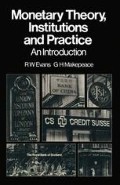Abstract
The London money markets are a collection of markets in which short-term assets are traded. They consist of the money or discount market and the remaining, parallel markets. The distinction has historical roots. Traditionally the operation of the banking sector revolved around the activities of the clearing banks, and the discount market provided the clearing banks with liquid assets. Further, the payments mechanism was largely based on the use of clearing bank deposits as a medium of exchange and, to maintain confidence, the authorities supported the mechanism indirectly through the discount market. The Bank of England acted as a ‘lender of last resort’ to the market and supplied cash when the market experienced shortages. The market contributed to the safety of its funds by using the assets that it purchased as security for most of its borrowing.
Preview
Unable to display preview. Download preview PDF.
Bibliography
E. R. Shaw, The London Money Market (London: Heinemann, 1975).
J. S. G. Wilson, London Money Markets (Tilbury: Société Universitaire Européene de Recherches Financières, 1976).
Copyright information
© 1979 R. W. Evans and G. H. Makepeace
About this chapter
Cite this chapter
Evans, R.W., Makepeace, G.H. (1979). The London Money Markets. In: Monetary Theory, Institutions and Practice: An Introduction. Palgrave, London. https://doi.org/10.1007/978-1-349-16202-4_7
Download citation
DOI: https://doi.org/10.1007/978-1-349-16202-4_7
Publisher Name: Palgrave, London
Print ISBN: 978-0-333-25333-5
Online ISBN: 978-1-349-16202-4
eBook Packages: Palgrave Economics & Finance CollectionEconomics and Finance (R0)

